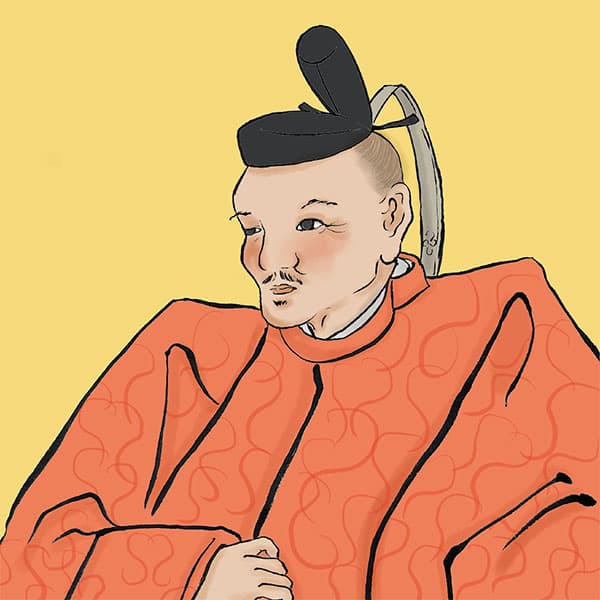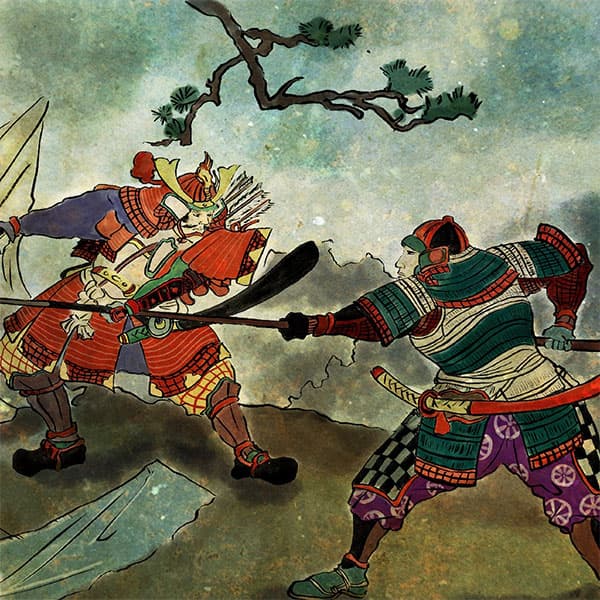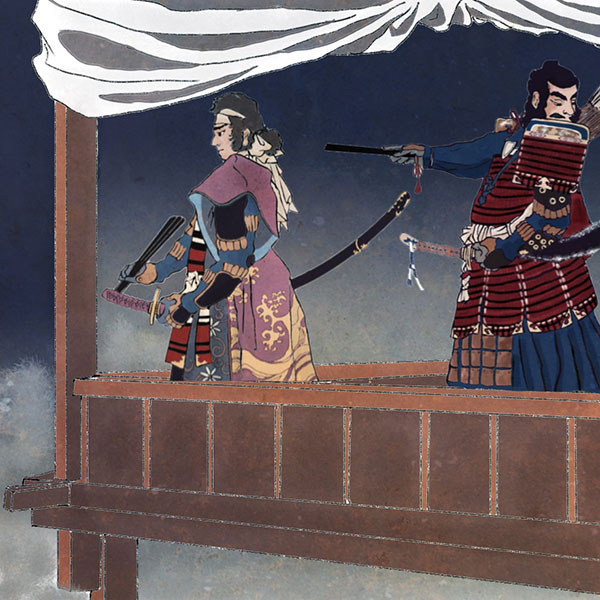Chikayoshi Hiraiwa (1/2)A loyal retainer who gained tremendous trust from the people of Japan.

Chikayoshi Hiraiwa
- Article category
- biography
- name
- Chikayoshi Hiraiwa (1542-1611)
- place of birth
- Aichi prefecture
- Related castles, temples and shrines

Inuyama Castle
National treasure tower
Kofu Castle
- related incident
The late Muromachi period was a time of war and turmoil, also known as the Sengoku period, which was compared to the history of China. It was Tokugawa Ieyasu who brought an end to this era. Supported by many retainers, Ieyasu established the Edo Shogunate and became a ruler of Japan. The representative retainers who supported Ieyasu are called the 16 Tokugawa Generals, and the most trusted retainer among them was Chikayoshi Hiraiwa. This time, we would like to take a look at Chikayoshi Hiraiwa, a retainer who gained tremendous trust from the people of Japan.
Chikayoshi Hiraiwa's period as pagehouse
Chikayoshi Hiraiwa was born in 1543 as the second son of Chikashige Hiraiwa in Sakazaki Village, Nukata District, Mikawa Province (currently Koda Town, Nukata District, Aichi Prefecture). His childhood name is Shichinosuke.
The Hiraiwa family into which Chikayoshi was born lived in Mikawa Province.
At the time of Chikayoshi's father, Chikashige (Shinzaemon), he belonged to the Matsudaira clan and served Matsudaira Kiyoyasu and Hirotada. However, Chikashige Hiraiwa was angry at the rudeness of the samurai who came from Kyoto and stayed in Okazaki, and killed him. Therefore, it is said that he lived in seclusion in Sakazaki Village.
At this time, the Matsudaira family (later the Tokugawa family), which the Hiraiwa family served, was in a weak position, sandwiched between the Imagawa family in the east and the Oda family in the west.
Therefore, Hirotada Matsudaira's son Takechiyo (later Tokugawa Ieyasu) was sent to Sunpu (present-day Shizuoka City) as a hostage in Suruga Province (present-day eastern Shizuoka Prefecture).
Chikayoshi Hiraiwa also came to Sunpu as a page from Takechiyo and served Tokugawa Ieyasu from an early age.
In the first year of Genroku (1558), a large-scale revolt occurred among the people of Mikawa Province (Mikawa no Geki). The Imagawa family, which essentially ruled Mikawa Province, dispatched Tokugawa Ieyasu to subjugate the area. Ieyasu goes to the front and makes his first battle. Chiyayoshi also followed Ieyasu and made his first campaign.
Both Ieyasu and Chikayoshi were 15 years old.
However, in May 1560, Oda Nobunaga of Owari Province (present-day western Aichi Prefecture) defeated Yoshimoto Imagawa in the Battle of Okehazama, and Tokugawa Ieyasu became independent from the Imagawa clan.
During this period, Chikayoshi Hiraiwa also fought alongside Tokugawa Ieyasu and achieved military successes, including the unification of Mikawa Province and the subjugation of Totomi Province, which was part of Imagawa territory.
Tokugawa Nobuyasu's Fuyaku era
Tokugawa Ieyasu gained independence from the Imagawa clan in the Battle of Okehazama, and in 1562 he formed the Kiyosu Alliance with Oda Nobunaga.
While Tokugawa Ieyasu gained independence from the Imagawa family and formed an alliance with the Oda family, Chikayoshi Hiraiwa also followed Ieyasu and achieved many military exploits. Ieyasu also trusted Chikayoshi, who had served Ieyasu since he was a child and achieved great deeds.
Therefore, Ieyasu appointed Chikayoshi Hiraiwa, whom he trusted, to be the fief of Ieyasu's eldest son, Nobuyasu Matsudaira. In May 1567, Tokugawa Ieyasu's eldest son, Nobuyasu Matsudaira, married Oda Nobunaga's daughter, Tokuhime, and although they were only nine years old, they began living together at Okazaki Castle. In addition, Nobuyasu performed his first battle in the first year of Tensho (1573) and displayed bravery, and ruled Mikawa Province following in the footsteps of Tokugawa Ieyasu, who had annexed the Imagawa territory and moved there. It was said that Nobuyasu led the Mikawa clan, fought against the Takeda clan, and served his father Ieyasu well.
However, this happened in 1579.
One theory is that Nobuyasu was asked to commit seppuku by Oda Nobunaga.
The reason is still unknown, but it is said that Tokuhime had a bad relationship with his wife, Tokuhime, and Tokuhime had slandered his father, Nobunaga Oda, or that a factional conflict within the Tokugawa family developed and involved Oda Nobunaga. Chikayoshi Hiraiwa, who was assisting Nobuyasu, was surprised by this situation.
At this time, Chikayoshi Hiraiwa, who was Nobuyasu's vassal, took responsibility for himself and asked Nobunaga to settle a series of problems by presenting his head to Nobunaga. However, he is unable to prevent Nobuyasu's punishment, and feels responsible for it, so he refrains from being punished.
After living in seclusion for a while, he was forgiven by Ieyasu and returned as a direct retainer. It is said that upon this return, Chikayoshi made the vassals of the deceased Nobuyasu his own vassals.
By the way, after Nobuyasu committed suicide, there were others who, like Chikayoshi, went into hiding, and others who followed him and died. This is a story for later years. Kiyomasa Sakakibara (older brother of Yasumasa Sakakibara, founder of the Ueno Tatebayashi domain), who was also Nobuyasu's vassal, felt responsible for Nobuyasu's seppuku, and went into hiding just like Chikayoshi. Afterwards, Kiyomasa, who was called back by Ieyasu and became the lord of Kuno Castle, inherited Nobuyasu's hair that Chikayoshi Hiraiwa and his maid had, and built a grave at Kojoji Temple to worship Nobuyasu.
County government of Kai and transfer to Kanto
Oda Nobunaga, who was allied with Tokugawa Ieyasu, expanded his power mainly in the Kinki and Tokai regions.
However, in 1582, Nobunaga was killed by his subordinate Akechi Mitsuhide at Honnoji Temple. After that, there was a struggle for leadership within the Oda family between Hideyoshi Hashiba and Katsuie Shibata.
Meanwhile, Ieyasu was trying to expand his own power. He set his sights on Shinano (present-day Nagano Prefecture) and Kai (present-day Yamanashi Prefecture), which were former Takeda clan territories, and captured these territories using his vassals, mainly Masatsuna Okabe (Tensho Migo Province). Ran).
When Ieyasu annexed Kai Province by 1583, Chikayoshi Hiraiwa was ordered by Ieyasu to go there as the district head of Kai, working with Masatsuna Okabe to pacify the samurai of the area, including former retainers of Takeda, and to control the area. I will strive for stability. At the same time, construction of Kofu Castle began as the new capital.
However, as Hashiba Hideyoshi's power gradually grew, Ieyasu became Hideyoshi's vassal. Then, in 1590, Hideyoshi defeated the Hojo family in Kanto (Odawara Conquest) and ordered Ieyasu to transfer to Kanto (Kanto Relocation). When Ieyasu moved to the Kanto region, he also gave land to his retainers who had been following him until then. In recognition of his achievements and loyalty, Chikayoshi Hiraiwa was given 33,000 koku of Umayabashi in Ueno Province (present-day Gunma Prefecture).
Chief retainer of Owari clan and lord of Inuyama clan
When Toyotomi Hideyoshi died in 1598, Tokugawa Ieyasu came to power as ruler of the Kanto region. Mitsunari Ishida, the magistrate of the Toyotomi family, opposes Ieyasu.
In 1600, Tokugawa Ieyasu and Ishida Mitsunari clashed at Sekigahara, and Tokugawa Ieyasu won the battle and began to rule the country.
After the Battle of Sekigahara ended in 1601, Chikayoshi Hiraiwa returned from Ueno Province's Umayahashi domain to Kofu, Kai Province, was given 63,000 koku, and resided in Kofu Castle.
- related incident

- WriterTomoyo Hazuki(Writer)I have loved history and geography since my student days, and have enjoyed visiting historical sites, temples and shrines, and researching ancient documents. He is especially strong in medieval Japanese history and European history in world history, and has read a wide range of things, including primary sources and historical entertainment novels. There are so many favorite military commanders and castles that I can't name them, but I especially like Hisashi Matsunaga and Mitsuhide Akechi, and when it comes to castles, I like Hikone Castle and Fushimi Castle. Once you start talking about the lives of warlords and the history of castles, there's a side of you that can't stop talking about them.







